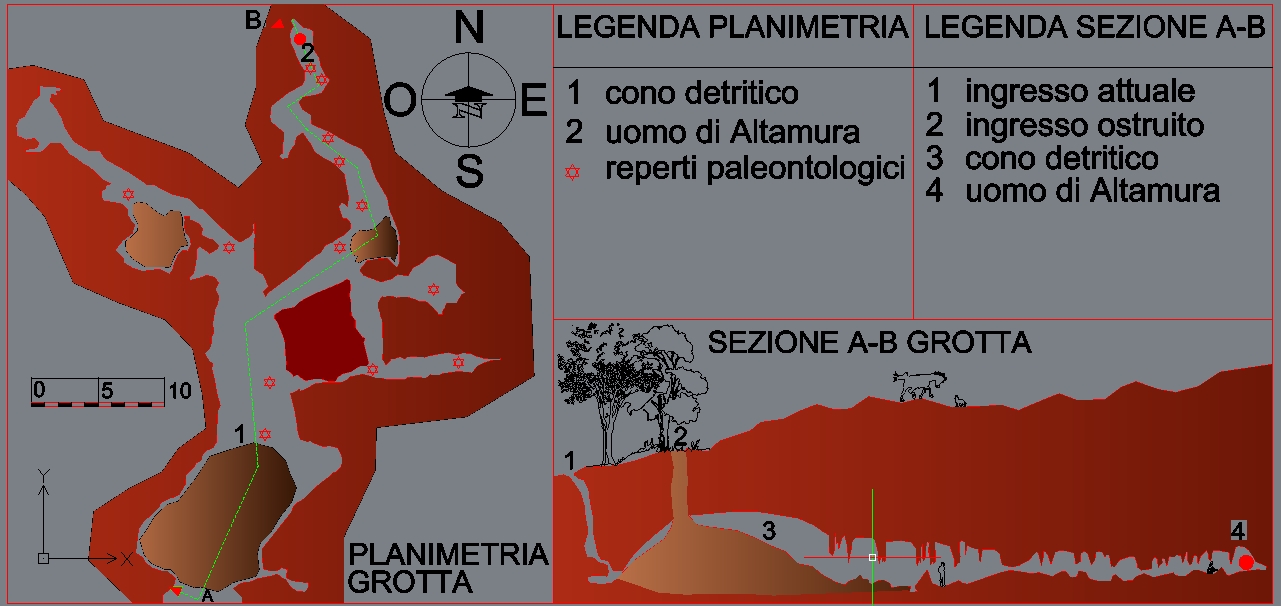 The so -called Man of Altamura was discovered on 7 October 1993 inside the Lamalunga cave (in the territory of Altamura, in the Province of Bari), by Lorenzo Di Liso , Marco Milillo and Walter Scaramuzzi , members of the Italian Alpine Club of Bari , invited to descend into the cave from the Altamurano Speleological Research Center (CARS) , considered instead the discoverer of the cave:
The so -called Man of Altamura was discovered on 7 October 1993 inside the Lamalunga cave (in the territory of Altamura, in the Province of Bari), by Lorenzo Di Liso , Marco Milillo and Walter Scaramuzzi , members of the Italian Alpine Club of Bari , invited to descend into the cave from the Altamurano Speleological Research Center (CARS) , considered instead the discoverer of the cave:


The one discovered in the Murgia of Bari is an adult human specimen of Neanderthal Homo , trapped in the Lamalunga cave in Altamura , which was incorporated into the stalactites and stalagmites that have grown around it and have kept it intact. The team led by Vittorio Pesce Delfino of the University of Bari put forward, immediately after the discovery, the first proposal for a phyletic location and the first estimate, on exclusively morphological bases, of the find; considering it a form of pre-Neanderthal. According to this hypothesis, the Man of Altamura had to place himself prior to the most ancient forms of classical Neanderthals and subsequently to the phases corresponding to Homo erectus . Consequently, the dating estimate predicted an interval between 400,000 and 100,000 years ago, with more probable values around 150-250,000 years ago. These first studies, conducted while preserving the find in its discovery site, absolutely avoiding the removal of bone fragments or related calcareous concretions, allowed us to recognize with certainty the typical Neanderthalian characters (morphology of the orbits and supraorbital bone thickenings, absence of canine fossa and presence of a clearly visible edge on the maxillary bone , thickening of the occipital bone, characteristic of the mastoid apophysis, existence of a retromolar space and course of the upper margin of the ascending branch of the mandible ). Some characteristics of the find associate characters that typically recur in Homo sapiens , among which, in particular, the convexity of the occipital bone scale:
The latest studies, performed vice versa by analyzing easily removable finds in the laboratory, have indicated a less uncertain dating but not in contradiction with the first estimate of Prof Vittorio Pesce Delfino ; the analyzes on the layers of calcite deposited around the find, carried out in 2015 by a team led by Giorgio Manzi , determined with certainty that the skeleton, attributable to a Neanderthal, dates back to a period between 128,000 and 187,000 years ago. The interest of the media in the paleoanthropological find Man of Altamura derives from numerous factors such as the naturalistic spectacle of the entire complex represented by the bones in the karst environment that concretised them, welding them to each other and making them absolutely fixed, the completeness of the skeleton , and the morphological characteristics mentioned. Reconstruction of the discovery :


Although the fossil was discovered in 1993 , the cave was discovered and explored already in 1989 by some cavers of the CARS , who however limited themselves only to a first environment since a plug of mud closed the connection with the other environments making the cave seem limited. to this unique environment. In 1991 , during another descent into the cave, the CARS speleologists noticed that there was a current of air coming from the other side of the mud plug, suggesting that the cave was not limited to that single environment. . Thus began the excavation work of a tunnel capable of allowing access and exploration of the remaining part of the cave:


these works lasted about two years and the first exploration of the main gallery and part of the branches was made on September 26, 1993. Present at that first exploration were the cavers of CARS, Gianni Dinardo, Manilo Porcelli, Giovanni Ragone, Vito Sardone, Angelo Squicciarini and Walter Scaramuzzi , partner of the Vespertilio CAI Speleological Group of Bari, at the invitation of Squicciarini. The exploration of the main chamber ended on 30 September of that same year, when after a hundred meters the CARS operators reached the bottom of the tunnel on which two branches opened, the west branch and the east branch, partially occluded by large boulders collapsed from the vault. On the morning of October 7, 1993, seven CARS speleologists descended again into the cave dividing into two groups; one group would take care of topographical surveys while the other group of further exploration and photographic surveys. The two groups were joined, in the middle of the morning, by the members of the Vespertilio CAI Speleological Group of Bari, Walter Scaramuzzi , Lorenzo di Lisio and Marco Milillo, got out to take some shots. During these operations Lorenzo di Lisio, followed by the other two CAI members, crept into one of the two tunnels of the east branch, characterized by many faunal remains, at the bottom of which, in what was later nicknamed apse , he discovered the bone deposit with a skull clearly attributable to a human form. The images taken that morning were viewed in the late evening of 7 October in the CARS headquarters, where three anthropologists from the University of Bari were also invited , including Eligio Vacca . Having realized the potential extraordinary nature of the discovery, the next morning, after having notified the Archaeological Superintendence of Puglia, the group of speleologists accompanied Eligio Vacca to the cave to allow him a direct view and therefore a more accurate analysis of the remains; of that descent remains a video in which Vacca described the bones that he was able to recognize, confirming the uniqueness of the discovery.
Chronological studies on about twenty faunal remains of the Lamalunga cave carried out with the Th-230 / U-234 method by Maria Elisabetta Branca and Mario Voltaggio of the IGAG-CNR in Rome and published in volume 2/2010 Dire in Puglia edited by MIBAC pp. 55-60, have highlighted how all the faunal remains analyzed found in the Lamalunga cave, in the rooms adjacent to the one where the Man of Altamura is located, have an age of deposition between 45,000 and 17,000 years from the present, with a maximum frequency between 45,000 and 30,000 years from the present. The age of deposition was deduced from the age of concretion of the calcite below and above the bone remains, respectively. In the Hall of Man (man’s antiabside), unfortunately, no underlying concretion or related to the Man himself has been observed except for the concretions overlying the skeleton and present above all in the area of the skull, which, however, have not been analyzed in order not to alter the finding. However, the beginning of concretion of the of the Hall of Man, around 170,000 (study carried out on a fallen stalactite) and the end of the same which occurred 17,000 years from the present (age of cavoliform calcite that uniformly covers all the speleothems of the Hall of Man and the eyebrow arches of the man himself). The only faunal remains analyzed in the human room was deposited before 36,000 years ago (age of a concretion overlying a deer vertebra). The probable features of the man from Altamura have been reconstructed. DNA analysis of the man from Altamura :
A subsequent study carried out in 2015 by a team led by Giorgio Manzi examined a fragment of shoulder bone through uranium-thorium dating on the calcite layers around the find, and this provided a reliable dating of the skeleton between 128,000 and 187,000 years. from the present. The study was also picked up by the journal Nature . In this regard, we report below the links to some videos disseminated on the web:
Deepening. The man from Altamura – video link:
TG CHANNEL 2_ALTAMURA: THE SKULL OF THE MAN OF ALTAMURA TO DEEPEN STUDIES – video link:
https://www.youtube.com/watch?v=W97HRzbhW70
L ‘Uomo di Altamura – Episode of 30/04/2016 by Ulysses (Rai3, with Alberto Angela) – video link:
Sources:
https://it.wikipedia.org/wiki/Uomo_di_Altamura
https://www.nature.com/articles/520008a
https://en.wikipedia.org/wiki/Altamura_Man



